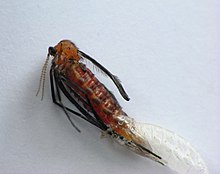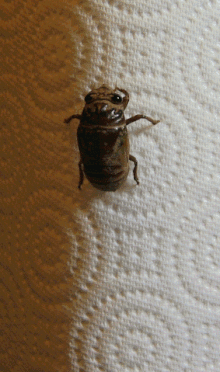This article needs additional citations for verification. (May 2024) |


Ecdysis is the moulting of the cuticle in many invertebrates of the clade Ecdysozoa. Since the cuticle of these animals typically forms a largely inelastic exoskeleton, it is shed during growth and a new, larger covering is formed.[1] The remnants of the old, empty exoskeleton are called exuviae.[2]
After moulting, an arthropod is described as teneral, a callow; it is "fresh", pale and soft-bodied. Within one or two hours, the cuticle hardens and darkens following a tanning process analogous to the production of leather.[3] During this short phase the animal expands, since growth is otherwise constrained by the rigidity of the exoskeleton. Growth of the limbs and other parts normally covered by the hard exoskeleton is achieved by transfer of body fluids from soft parts before the new skin hardens. A spider with a small abdomen may be undernourished but more probably has recently undergone ecdysis. Some arthropods, especially large insects with tracheal respiration, expand their new exoskeleton by swallowing or otherwise taking in air. The maturation of the structure and colouration of the new exoskeleton might take days or weeks in a long-lived insect; this can make it difficult to identify an individual if it has recently undergone ecdysis.
Ecdysis allows damaged tissue and missing limbs to be regenerated or substantially re-formed. Complete regeneration may require a series of moults, the stump becoming a little larger with each moult until the limb is a normal, or near normal, size.[4]
- ^ John Ewer (2005). "How the ecdysozoan changed its coat". PLOS Biology. 3 (10): e349. doi:10.1371/journal.pbio.0030349. PMC 1250302. PMID 16207077. S2CID 624103.
- ^ O. Erik Tetlie, Danita S. Brandt & Derek E. G. Briggs (2008). "Ecdysis in sea scorpions (Chelicerata: Eurypterida)". Palaeogeography, Palaeoclimatology, Palaeoecology. 265 (3–4): 182–194. Bibcode:2008PPP...265..182T. doi:10.1016/j.palaeo.2008.05.008.
- ^ Russell Jurenka (2007). "Insect physiology". In Sybil P. Parker (ed.). McGraw-Hill Encyclopedia of Science & Technology. Vol. 9 (10th ed.). McGraw-Hill Companies,Incorporated. p. 323. ISBN 978-0-07-144143-8.
- ^ Penny M. Hopkins (2001). "Limb regeneration in the fiddler crab, Uca pugilator: hormonal and growth factor control". American Zoologist. 41 (3): 389–398. doi:10.1093/icb/41.3.389.